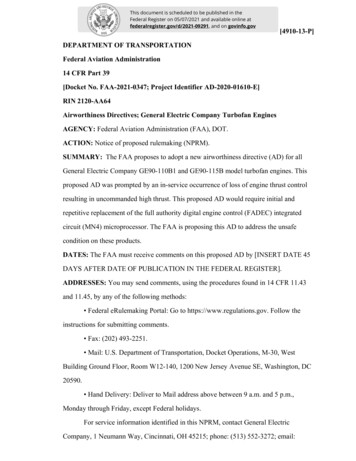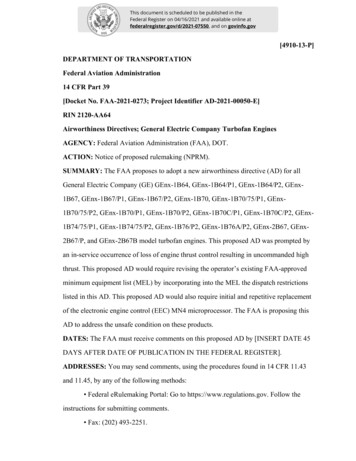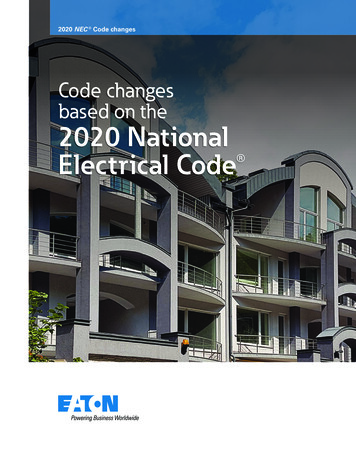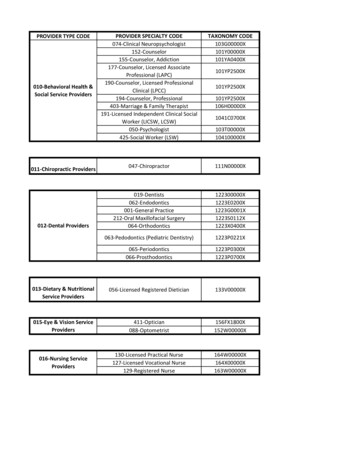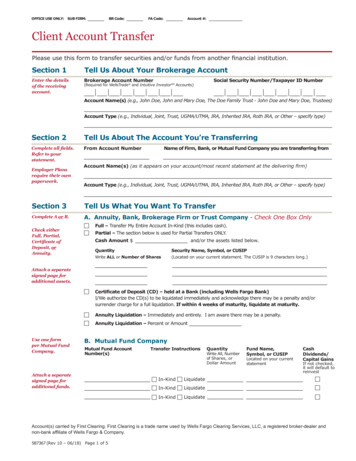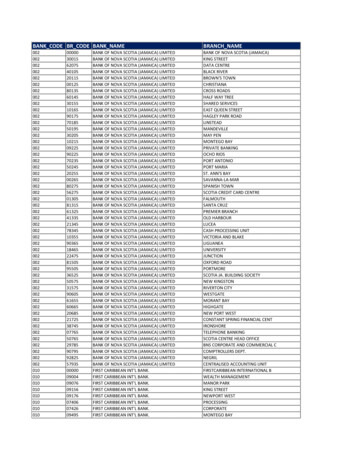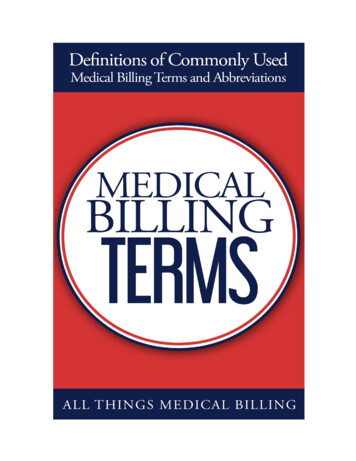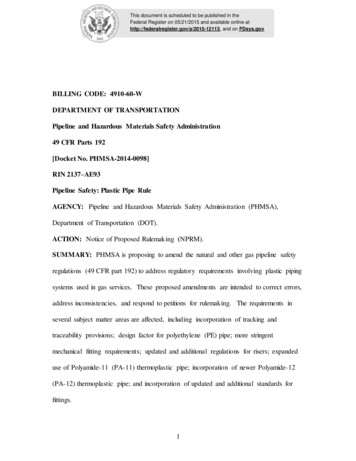
Transcription
This document is scheduled to be published in theFederal Register on 05/21/2015 and available online athttp://federalregister.gov/a/2015-12113, and on FDsys.govBILLING CODE: 4910-60-WDEPARTMENT OF TRANSPORTATIONPipeline and Hazardous Materials Safety Administration49 CFR Parts 192[Docket No. PHMSA-2014-0098]RIN 2137–AE93Pipeline Safety: Plastic Pipe RuleAGENCY: Pipeline and Hazardous Materials Safety Administration (PHMSA),Department of Transportation (DOT).ACTION: Notice of Proposed Rulemaking (NPRM).SUMMARY: PHMSA is proposing to amend the natural and other gas pipeline safetyregulations (49 CFR part 192) to address regulatory requirements involving plastic pipingsystems used in gas services. These proposed amendments are intended to correct errors,address inconsistencies, and respond to petitions for rulemaking. The requirements inseveral subject matter areas are affected, including incorporation of tracking andtraceability provisions; design factor for polyethylene (PE) pipe; more stringentmechanical fitting requirements; updated and additional regulations for risers; expandeduse of Polyamide-11 (PA-11) thermoplastic pipe; incorporation of newer Polyamide-12(PA-12) thermoplastic pipe; and incorporation of updated and additional standards forfittings.1
DATES: Submit comments on or before July 31, 2015.ADDRESSES: Comments should reference Docket No. PHMSA-2014-0098 and maybe submitted in the following ways: E-Gov Website: http://www.regulations.gov. This website allows the public toenter comments on any Federal Register notice issued by any agency. Followthe instructions for submitting comments. Fax: 1-202-493-2251. Mail: Docket Management System: U.S. Department of Transportation, DocketOperations, M-30, Room W12-140, 1200 New Jersey Avenue, SE, Washington,DC 20590-0001. Hand Delivery: DOT Docket Management System, West Building Ground Floor,Room W12-140, 1200 New Jersey Avenue, SE, Washington, DC 20590-0001between 9 a.m. and 5 p.m., Monday through Friday, except Federal holidays.Instructions: If you submit your comments by mail, please submit two copies. Toreceive confirmation that PHMSA received your comments, include a self-addressedstamped postcard.Note: Comments are posted without changes or edits to http://www.regulations.gov,including any personal information provided. There is a privacy statement published onhttp://www.regulations.gov.Privacy Act Statement2
In accordance with 5 U.S.C. 553(c), DOT solicits comments from the public tobetter inform its rulemaking process. DOT posts these comments, without edit, includingany personal information the commenter provides, to www.regulations.gov, as describedin the system of records notice (DOT/ALL–14 FDMS), which can be reviewed atwww.dot.gov/privacy.FOR FURTHER INFORMATION CONTACT:General Information: Cameron Satterthwaite, Transportation Specialist, by telephone at202-366-1319, or by electronic mail at cameron.satterthwaite@dot.gov.Technical Questions: Max Kieba, General Engineer, by telephone at 202-493-0595, or byelectronic mail at max.kieba@dot.gov.SUPPLEMENTARY INFORMATION:I. BackgroundThe use and availability of plastic pipe have changed over the years withtechnological innovations in the products and best practices used in plastic pipeinstallations. Progress in the design and manufacture of plastic pipe and components hasresulted in materials with higher strength characteristics. Manufacturers are institutingnew practices related to traceability. Operators are incorporating best practices.Together, these measures have the potential to improve with pipeline safety and integrity.Some of these strides have been highlighted in petitions that are detailed below. Thepipeline safety regulations have not stayed current with some of these products; thisrulemaking is an effort to propose a number of revisions to incorporate these changes inthe interest of pipeline safety.3
PHMSA has received several rulemaking petitions involving plastic pipe. Copiesof these petitions have been placed in the docket (PHMSA-2014-0098) for thisrulemaking in addition to the docket that may have been initially established for thepetition. This proposed rule will address the following petitions: American Gas Association (AGA) - (Docket No. PHMSA 2010-0011) –Petition to increase design factor 0.32 to 0.4 and incorporate updatedASTM D2513 (standard for Polyethylene (PE) pipe). Evonik Industries (Evonik) and UBE Industries (UBE) - (Docket No.PHMSA 2010-0009) – Petition to allow use of Polyamide (PA-12) pipe. Arkema - (Docket No. PHMSA 2013-0227) – Petition to allow use ofPolyamide (PA-11) pipe at higher pressures. Gas Piping Technology Committee (GPTC) – Petition to allow aboveground, encased plastic pipe for regulator and metering stations.While there has been much progress, both Federal and State inspectors, havenoticed some issues related to the installation of plastic pipe that should be addressed inthe pipeline safety regulations. In an effort to address these issues, respond to petitionsand update the regulations with respect to the products and practices used in plastic pipesystem without compromising safety, PHMSA is proposing revisions to the FederalPipeline Safety Regulations (PSR) in 49 CFR part 192. This focus will limit theseproposals to plastic pipelines in gas service and subsequently to new, repaired, andreplaced pipes. These issues are addressed and detailed below as follows:A. Tracking and TraceabilityB. Design Factor for PE4
C. Expanded use of PA-11D. Incorporation of PA-12E. RisersF. FittingsG. Plastic Pipe InstallationG.1. - Installation by Trenchless Excavation (§§ 192.3, 192.329, and192.376)G.2. - Joining Plastic Pipe (§ 192.281)G.3. - Qualifying Joining Procedures (§ 192.283)G.4. - Qualifying Persons to Make Joints (§ 192.285)G.5. - Bends (§ 192.313)G.6. - Installation of Plastic Pipe (§ 192.321)G.7. - Service Lines; General Requirements for Connections to MainPiping (§ 192.367)G.8. - Equipment Maintenance; Plastic Pipe Joining (§192.756)H. RepairsH.1. – Repair of Plastic Pipe – Gouges (§ 192.311)H.2. – Leak Repair Clamps (§ 192.720)I. General ProvisionsI.1. - Incorporation by Reference (§ 192.7)I.2. - Plastic Pipe Material (§ 192.59)I.3. - Plastic Pipe Storage and Handling (§ 192.67)I.4. - Gathering Lines (§ 192.9)5
I.5. - Merger of Sections 192.121 and 192.123I.6. - General Design Requirements for Components (§ 192.143)I.7. - General Design Requirements for Valves (§ 192.145)I.8. - General Design Requirements for Standard Fittings (§ 192.149)I.9. - Test Requirements for Plastic Pipelines (§ 192.513)A. Traceability and TrackingIn many cases, the lack of adequate traceability for plastic pipe (i.e., appropriatemarkings that help identify the location of manufacture, lot information, size, material,pressure rating, temperature rating and, as appropriate, type, grade, and model, etc., of thepipe and components) and tracking of pipe location (i.e., a means of identifying thelocation of pipe and components within the pipeline) prevents operators from havingenough information to identify systemic issues related to incidents involving plastic pipe.Further, the lack of this information makes it difficult for operators and regulators todetermine whether plastic pipe or component failures are related to a certain type orvintage of material, specific product defect or design, heat/lot of the product, or whetherit was produced by a certain manufacturer at a certain time.In addition, the issue can result in excessive pipe excavations due to an inabilityto locate the affected sections of pipe or fittings when responding to plastic pipe orcomponent manufacturer recalls. In 2001, the National Association of Pipeline SafetyRepresentatives (NAPSR), a non-profit organization of State pipeline safety personnelthat promotes pipeline safety in the United States and its territories, also noted this issuein its RESOLUTION NO. 2001-2-SR-2-01 (Resolution SR-2-01). In its Resolution,6
NAPSR referred to accident investigations where insufficient data regarding the pipematerial (i.e., date of manufacture and other relevant information) had proven to be anobstacle in determining the cause or origin of an incident. NAPSR also recognized thatexisting pipe, fittings, and components often do not maintain their markings for asufficient period of time to provide useful tracking and traceability information.Therefore, NAPSR requested that PHMSA revise § 192.63 (“Marking of Materials”) torequire the marking of all pipe and components to ensure identification for a period of 50years or the life of the pipeline. NAPSR also expressed the view that the marking ofplastic pipe, fittings, and components will benefit the industry and public by allowing theidentification of problems and proactively mitigating future problems through suchidentification.In an effort to address the concerns mentioned above and to address the resolutionfrom NAPSR, PHMSA proposes new requirements for tracking and traceability of plasticpipe and components that extend beyond marking alone. To set the framework fortracking and traceability, PHMSA proposes to revise § 192.3 by adding definitions for“traceability information” and “tracking information.” It is PHMSA’s intent that alloperators have methods to identify the location of pipe, the person who joined the pipe,and components within the pipeline (i.e., tracking). PHMSA also proposes that operatorsbe required to identify and document the location of pipe manufacture, production, lotinformation, size, material, pressure rating, temperature rating, and, as appropriate, otherinformation such as type, grade, and model (i.e., traceability). In order to facilitatecompliance, PHMSA proposes to revise § 192.63 to require operators to adopt thetracking and traceability requirements in ASTM F2897-11a, “Standard Specification for7
Tracking and Traceability Encoding System of Natural Gas Distribution Components(Pipe, Tubing, Fittings, Valves, and Appurtenances)” (Standard). Note that the Standardonly specifies requirements for information that marks pipe and components with a 16digit code to help identify characteristics such as manufacturer, material type, lot code,etc. While the Standard gives some examples of the types of markings, such as barcodes,2D-Data matrix, or a more conventional print line, it does not provide the actual means ofmarking or affixing the code to the components, the means of reading and transferring thedata or codes, and the durability of the markings.In response to the 2001 NAPSR Resolution, PHMSA also proposes to clarify§ 192.63 by expressly providing that specification and traceability markings on plasticpipe be legible, visible, and permanent in accordance with the pipe’s listed specification.The proposed revisions in § 192.63 also reference the recordkeeping requirements forthese markings in §§ 192.321(k) and 192.375(d). Section 192.321 applies to theinstallation of plastic pipe used for transmission lines and mains, and § 192.375 containsrequirements for plastic service lines.PHMSA further proposes to add a new paragraph (k) to § 192.321 and a newparagraph (d) to § 192.375 to require operators to maintain tracking and traceabilityinformation (as defined in § 192.3) records for the life of the pipeline. PHMSA believesthis performance-based approach will allow for the use of other methods andtechnologies. For instance, during construction or repair, operators may choose to use aGlobal Positioning System (GPS) in combination with a barcode reader to help mark thelocation or identify other features of the pipe or component. Other operators without themeans to purchase such equipment may choose to collect and store the information8
manually or electronically. The purpose of these proposed revisions is to enableoperators to accurately locate and quickly identify the installed pipe and components intheir systems when handling recalls and conducting failure investigations. The revisionsalso support the requirements in the distribution integrity management programs forcapturing and retaining certain information on new pipelines for the life of the lines(§ 192.1007(a)(5)). In addition, the proposed requirement would also support the currentplastic pipe-joiner qualification requirements in § 192.285.B. Design Factor of PEPHMSA received petitions from the American Gas Association (AGA) and theGas Piping Technology Committee (GPTC) to increase the design factor for PE pipefrom 0.32 to 0.40 in § 192.121. The allowable design pressure for plastic is based on anumber of factors, including the stress rating of the material (interpolated from aHydrostatic Design Basis (HDB) rating), wall thickness and diameter or standarddimension ratio (SDR), and design factor. The allowable design factor is currently 0.32for plastics. The exception to this design factor limitation applies to Polyamide-11 pipe(PA-11) produced after January 23, 2009, meeting certain conditions, which would allowthe design factor to increase to 0.40. The petitions to allow for a 0.40 design factor forPE pipe are based on research and technical justifications performed by the GasTechnology Institute (GTI) and include certain limitations by type of material and wallthickness. Since design pressure for plastic pipe is based on a number of variables,including design factor and wall thickness, an increase in design factor would allow forthe use of PE pipe with smaller wall thicknesses while limited to the allowable pressures9
determined in § 192.121 if the pipe is made from higher quality material and meets otherlimitations mentioned in the petitions. Furthermore, a design factor of 0.40 is alreadyallowed in § 192.121 for PA-11 pipe with certain limitations. Upon review, PHMSAproposes to adopt this provision into the PSR. The details of the proposal are specifiedbelow under “G. Plastic Pipe Installation.”C. Expanded Use of PA-11Polyamide-11, also referred to as Nylon 11, is a relatively ne
ASTM D2513 (standard for Polyethylene (PE) pipe). Evonik Industries (Evonik) and UBE Industries (UBE) - (Docket No. PHMSA 2010-0009) – Petition to allow use of Polyamide (PA-12) pipe. Arkema - (Docket No. PHMSA 2013-0227) – Petition to allow use of Polyamide (PA-11) pipe at higher pressures. Gas Piping Technology Committee (GPTC) – Petition to allow above-ground, encased plastic pipe for .

